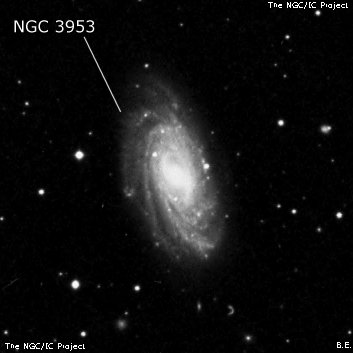
16x80 finder (3/19/88): visible as a fairly large, elongated patch.
William Herschel discovered NGC 3953 = H V-45 = h1011 on 12 Apr 1789 (sweep 919) and recorded "cB, Br N with F branches, 6 or 7' l, 3 or 4' br." JH reported "B; L; vsbM; r; 3' diam. Fine object."
It has been proposed that NGC 3953, and not NGC 3992, is the object discovered by Pierre Méchain, and associated with M109. See http://www.astrobril.nl/FortinOther.html M109
Bindon Stoney, LdR's assistant on 3 Mar 1851, reported "S neb, vF, 6' npp." Although this object was not mentioned again in 3 later observations at Birr Castle, it probably refers to 16th magnitude PGC 2412642, 4.5' WNW of center (Steinicke concurs). R.J. Mitchell sketched the galaxy on 19 Apr 1857 at Birr Castle (included in LdR's 1861 publication).
400/500mm - 17.5" (3/19/88): very bright, very large, elongated ~N-S, 5'x2', very bright core, stellar nucleus. A mag 13 star is at the west edge, 0.9' from the center, and a brighter mag 11 star is off the NE side, 2.7' from center. NGC 3953 is a member of the NGC 3992 (M109) group = LGG 258.
900/1200mm - 48" (5/2/19): at 375x and 545x; very bright, large spiral with 3 visible arms, extending .nearly 6'x2.5' SSW-NNE The galaxy is sharply concentrated with a very bright, round nucleus. A moderate contrast bar extends through the nucleus in a SW-NE orientation. A long, gently curving spiral arm extends north into the outer halo and curves counterclockwise to the NE. A low contrast, long spiral arm (~2.5' in length) drapes due south on the east side of the core/bar. A mag 14.5 star is just within this arm [0.9' NE of center]. An extremely faint HII patch is east of this arm at the edge of the halo [1.4' E of center]. Finally, an outer section of the southern spiral arm was easily seen and brightest in a patch at the south tip [2' from center]. The arms bends sharply from SW to NE at the outer end. A mag 14 star is close to the W edge [51" from center].
Notes by Steve Gottlieb